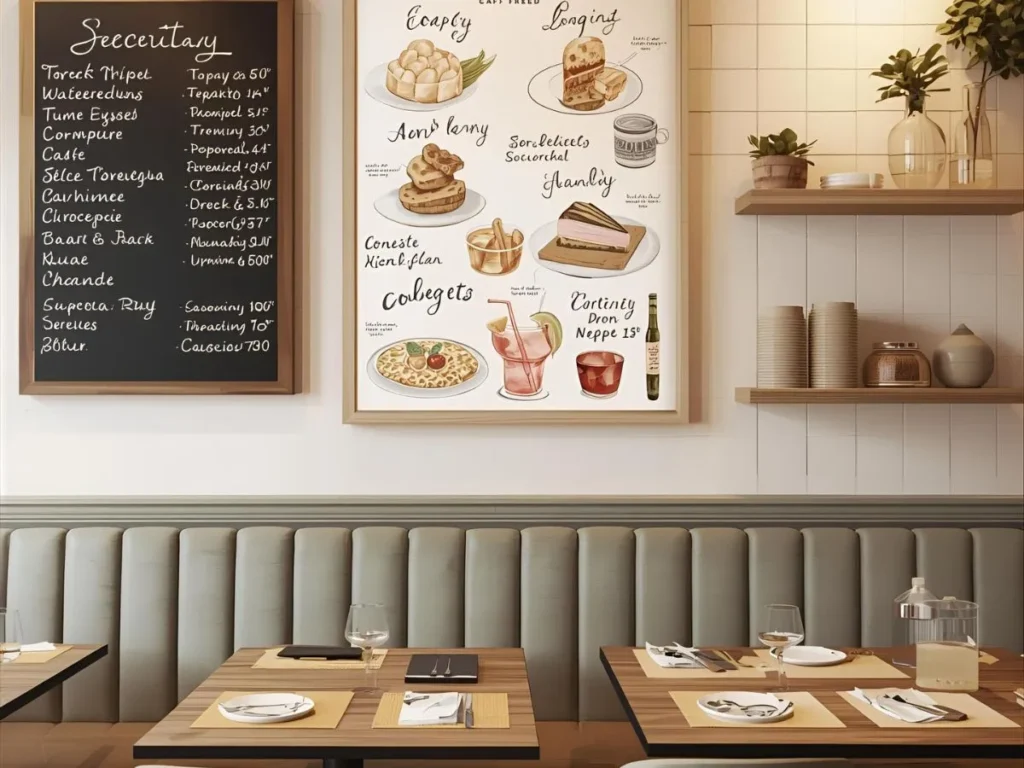Imagine you’re working at a busy restaurant, and a group of Spanish-speaking guests walks in. They smile, wave, and start talking but you can’t quite understand them. That’s where Spanish phrases for restaurant workers come to the rescue.
If you’re a waiter, chef, or manager, knowing a few key Spanish words can make your job easier and your guests happier. It’s not about being fluent it’s about connection.
In this guide, we’ll explore practical Spanish phrases for restaurant workers that you can start using today.
From greetings and food orders to handling complaints and giving compliments, you’ll have everything you need to make your Spanish-speaking customers feel welcome and respected.
Why It Matters 🌎
The restaurant world is all about people. And with millions of Spanish speakers worldwide, it’s likely that many of your customers or even coworkers speak Spanish.
Understanding Spanish phrases for restaurant workers helps you create a better dining experience and avoid misunderstandings.
Think about it if a customer says, . By learning a few basic phrases, you show respect for the customer’s needs and culture.
It makes guests feel seen and valued, especially when they realize you made the effort to communicate in their language.
Greetings and Customer Welcomes 👋

Hola, bienvenidos al restaurante
Meaning: Hello, welcome to the restaurant.
Use When: Greeting guests as they enter.
Example: “¡Hola, bienvenidos al restaurante! ¿Cuántas personas?” (Hello, welcome to the restaurant! How many people?)
¿Cuántas personas son?
Meaning: How many people are you?
Use When: Seating customers at their table.
Example: “¿Cuántas personas son para la mesa?” (How many people for the table?)
¿Cómo está hoy?
Meaning: How are you today?
Use When: Offering friendly small talk.
Example: “¿Cómo está hoy? Me alegra verle otra vez.” (How are you today? Glad to see you again.)
Pase por aquí, por favor
Meaning: This way, please.
Use When: Guiding customers to their seats.
Example: “Pase por aquí, por favor. Su mesa está lista.” (This way, please. Your table is ready.)
Taking Orders 📝
¿Qué desea ordenar?
Meaning: What would you like to order?
Use When: Asking guests for their order.
Example: “¿Qué desea ordenar hoy?” (What would you like to order today?)
¿Le gustaría algo para beber?
Meaning: Would you like something to drink?
Use When: Offering beverages before taking the main order.
Example: “¿Le gustaría algo para beber mientras espera?” (Would you like something to drink while you wait?)
¿Cómo quiere su carne?
Meaning: How do you want your meat cooked?
Use When: Clarifying meat doneness for steaks or burgers.
Example: “¿Cómo quiere su carne—bien cocida o término medio?” (How would you like your meat—well done or medium?)
¿Desea algo más?
Meaning: Would you like anything else?
Use When: Checking if the customer wants additional items.
Example: “¿Desea algo más, tal vez un postre?” (Would you like anything else, maybe a dessert?)
Food and Menu Vocabulary 🍔

El menú / La carta
Meaning: The menu.
Use When: Handing or referring to the menu.
Example: “Aquí tiene el menú.” (Here’s the menu.)
Plato principal
Meaning: Main dish.
Use When: Explaining course options.
Example: “Este es nuestro plato principal del día.” (This is our main dish of the day.)
Entrada / Aperitivo
Meaning: Starter or appetizer.
Use When: Describing the first course.
Example: “La sopa de tomate es una buena entrada.” (The tomato soup is a good starter.)
Postre
Meaning: Dessert.
Use When: Offering sweet options.
Example: “¿Quiere ver el menú de postres?” (Would you like to see the dessert menu?)
Bebidas
Meaning: Drinks.
Use When: Offering drink options.
Example: “Tenemos bebidas frías y calientes.” (We have cold and hot drinks.)
Serving and Checking In 🍽️
¿Todo está bien con su comida?
Meaning: Is everything okay with your food?
Use When: Checking if customers are satisfied.
Example: “¿Todo está bien con su comida?” (Is everything okay with your food?)
¿Necesita algo más?
Meaning: Do you need anything else?
Use When: Offering extra help during service.
Example: “¿Necesita algo más, más pan o agua?” (Do you need anything else—more bread or water?)
Buen provecho
Meaning: Enjoy your meal.
Use When: Before guests start eating.
Example: “Aquí está su comida. ¡Buen provecho!” (Here’s your food. Enjoy your meal!)
Le traigo la cuenta
Meaning: I’ll bring you the check.
Use When: Informing the guest that you’re bringing the bill.
Example: “Le traigo la cuenta en un momento.” (I’ll bring you the check in a moment.)
Handling Special Requests and Issues ⚠️

Sin cebolla / Sin sal
Meaning: Without onion / Without salt.
Use When: Guests request specific changes.
Example: “El cliente pidió la ensalada sin cebolla.” (The customer asked for the salad without onion.)
Lo siento por la espera
Meaning: Sorry for the wait.
Use When: Apologizing for delays.
Example: “Lo siento por la espera, su comida estará lista pronto.” (Sorry for the wait, your food will be ready soon.)
Ya lo arreglo
Meaning: I’ll fix it right away.
Use When: Responding to a complaint or mistake.
Example: “Lo siento, ya lo arreglo.” (I’m sorry, I’ll fix it right away.)
Gracias por su paciencia
Meaning: Thank you for your patience.
Use When: Showing appreciation to waiting customers.
Example: “Gracias por su paciencia, estamos terminando su pedido.” (Thank you for your patience; we’re finishing your order.)
Team Communication 👩🍳👨🍳
La mesa cuatro está lista
Meaning: Table four is ready.
Use When: Notifying coworkers about table status.
Example: “La mesa cuatro está lista para los clientes.” (Table four is ready for the guests.)
Falta un plato
Meaning: One dish is missing.
Use When: Reporting an incomplete order.
Example: “Falta un plato en la orden de la mesa tres.” (One dish is missing from table three’s order.)
Necesitamos más pan
Meaning: We need more bread.
Use When: Requesting more items from the kitchen.
Example: “Necesitamos más pan para las mesas del fondo.” (We need more bread for the back tables.)
Listo para servir
Meaning: Ready to serve.
Use When: Indicating food is ready to go out.
Example: “El pedido de la mesa cinco está listo para servir.” (The order for table five is ready to serve.)
Farewell and Gratitude 💬
Gracias por venir
Meaning: Thank you for coming.
Use When: Saying goodbye to guests.
Example: “Gracias por venir, que tenga un buen día.” (Thank you for coming; have a nice day.)
Esperamos verle pronto
Meaning: We hope to see you soon.
Use When: Encouraging return visits.
Example: “Esperamos verle pronto. ¡Gracias por su visita!” (We hope to see you soon. Thanks for visiting!)
Que tenga un buen día
Meaning: Have a good day.
Use When: Wishing customers well as they leave.
Example: “Que tenga un buen día y gracias por venir.” (Have a good day, and thanks for coming.)
Vuelva pronto
Meaning: Come back soon.
Use When: Creating a warm farewell.
Example: “Vuelva pronto. ¡Nos encanta servirle!” (Come back soon. We love serving you!)
Bonus Recap Table 🧾
| Category | Phrase (Spanish) | Meaning | Example Use |
|---|---|---|---|
| Greeting | Hola, bienvenidos al restaurante | Hello, welcome to the restaurant | Welcoming guests |
| Orders | ¿Qué desea ordenar? | What would you like to order? | Taking food orders |
| Food Terms | Postre | Dessert | Offering sweet options |
| Serving | ¿Todo está bien con su comida? | Is everything okay with your food? | Checking satisfaction |
| Issues | Lo siento por la espera | Sorry for the wait | Apologizing for delay |
| Team Talk | Listo para servir | Ready to serve | Coordinating with kitchen |
| Farewell | Gracias por venir | Thank you for coming | Saying goodbye |
Final Thoughts 💡
Learning Spanish phrases for restaurant workers isn’t about mastering grammarit’s about connecting with people. Even a few words can brighten a customer’s day and make your service stand out.
Every smile, every “gracias,” builds a bridge between languages and cultures. And in the restaurant world, those small bridges can turn a simple meal into a memorable experience.


Leave a Reply